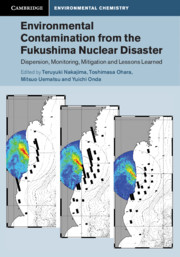 Environmental Contamination from the Fukushima Nuclear Disaster
Environmental Contamination from the Fukushima Nuclear Disaster Book contents
- Environmental Contamination from the Fukushima Nuclear Disaster
- Cambridge Environmental Chemistry Series
- Environmental Contamination from the Fukushima Nuclear Disaster
- Copyright page
- Contents
- Contributors
- Preface
- Acknowledgements
- Part I Transport of Radioactive Materials in the Environment
- 1 Introduction
- 2 Estimation of Environmental Releases of Radioactive Materials
- 3 Diffusion in the Atmosphere
- 4 Global Transport of Radioactive Materials
- 5 Ocean Transport of Radioactive Materials
- 6 Diffusion and Deposition of Radioactive Materials in the Terrestrial Environment
- Part II Development and Future Issues for the Infrastructure of Disaster Prevention
- Part III Lessons and Future Issues from the Fukushima Accident
- Glossary
- Names of Locations
- Index
- References
2 - Estimation of Environmental Releases of Radioactive Materials
from Part I - Transport of Radioactive Materials in the Environment
Published online by Cambridge University Press: 16 August 2019
- Environmental Contamination from the Fukushima Nuclear Disaster
- Cambridge Environmental Chemistry Series
- Environmental Contamination from the Fukushima Nuclear Disaster
- Copyright page
- Contents
- Contributors
- Preface
- Acknowledgements
- Part I Transport of Radioactive Materials in the Environment
- 1 Introduction
- 2 Estimation of Environmental Releases of Radioactive Materials
- 3 Diffusion in the Atmosphere
- 4 Global Transport of Radioactive Materials
- 5 Ocean Transport of Radioactive Materials
- 6 Diffusion and Deposition of Radioactive Materials in the Terrestrial Environment
- Part II Development and Future Issues for the Infrastructure of Disaster Prevention
- Part III Lessons and Future Issues from the Fukushima Accident
- Glossary
- Names of Locations
- Index
- References
Summary
The Fukushima Daiichi Nuclear Power Station (FDNPS) accident in Japan on 11 March 2011, which was triggered by a magnitude 9.0 earthquake that resulted in a tsunami, caused a month-long discharge of radioactive materials into the atmosphere. However, in the first stage of the accident, only monitoring cars near the FDNPS could collect monitoring data because of damage to the monitoring posts and stack monitor. The limited survey data from the monitoring cars from 12–13 March 2011 (NISA, 2011) showed that radioactive caesium and iodine were already detected at Okuma-machi and Namie-machi, close to the FDNPS around 8:00 JST on 12 March due to leakage from the containment vessel. In addition, increased air dose rates due to the deposition of radionuclides discharged by a hydrogen explosion at unit 1 were observed north of the FDNPS on 13 March.
- Type
- Chapter
- Information
- Environmental Contamination from the Fukushima Nuclear DisasterDispersion, Monitoring, Mitigation and Lessons Learned, pp. 50 - 61Publisher: Cambridge University PressPrint publication year: 2019


